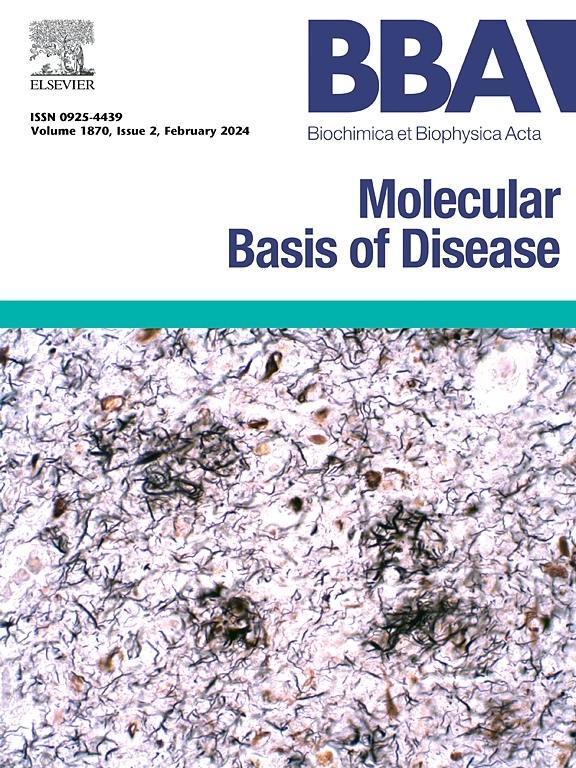靶向可调纳米载体的相互作用、理化性质及未来发展趋势
IF 4.2
2区 生物学
Q2 BIOCHEMISTRY & MOLECULAR BIOLOGY
Biochimica et biophysica acta. Molecular basis of disease
Pub Date : 2025-06-18
DOI:10.1016/j.bbadis.2025.167956
引用次数: 0
摘要
靶向纳米技术已经成为一种很有前途的药物传递系统方法,提供增强的治疗效果和减少的副作用。纳米载体的物理化学性质在很大程度上影响了纳米载体在体内与其预期靶标的相互作用。诸如大小、形状、表面电荷和弹性等因素在决定纳米载体穿越生物屏障、逃避免疫系统和选择性地在靶点积累的能力方面起着至关重要的作用。纳米技术的最新进展导致了具有改进靶向能力的新型纳米载体的发展。这些创新的设计结合了对特定刺激(如pH值变化或酶活性)做出反应的智能材料,从而可以精确控制药物释放。了解和优化这些物理化学性质对于设计更有效和高效的靶向药物输送系统至关重要,可能会彻底改变各种疾病的治疗,特别是癌症治疗。此外,配体的表面修饰进一步增强了纳米载体-靶标相互作用的特异性。蛋白质电晕、肿瘤微环境、生物屏障和纳米颗粒的物理化学性质的交叉为癌症靶向治疗提供了一些挑战。此外,我们还讨论了利用受体、纳米载体系统靶向肿瘤的各种靶向方法的现状和存在的挑战,为未来靶向纳米药物递送系统的发展提供了基础。本文综述了从2015年到2025年纳米载体设计的进展,重点是癌症特异性靶向,提供了所有需要仔细研究的关键参数的全面分析,以选择最合适的纳米载体方法来成功的临床转化。本文章由计算机程序翻译,如有差异,请以英文原文为准。

A review on targeting tunable nanocarrier interaction, physiochemical properties, and futuristic nanocarrier
Targeting nanotechnology has emerged as a promising approach in drug delivery systems, offering enhanced therapeutic efficacy and reduced side effects. The physicochemical properties of nanocarriers largely influence the interaction of the nanocarrier within the body and its intended targets. Factors such as size, shape, surface charge, and elasticity play crucial roles in determining the nanocarrier's ability to navigate biological barriers, evade the immune system, and selectively accumulate at the target site. Recent advancements in nanotechnology have led to the development of newer nanocarriers with improved targeting capabilities. These innovative designs incorporate smart materials that respond to specific stimuli, such as pH changes or enzyme activity, allowing precise control over drug release. The understanding and optimization of these physicochemical properties are essential for designing more effective and efficient targeted drug delivery systems, potentially revolutionizing the treatment of various diseases, particularly in cancer therapy. Additionally, surface modifications with ligands further enhance the specificity of nanocarrier-target interactions. The intersection of protein corona, tumor microenvironment, biological barriers, and nanoparticles' physicochemical properties offers several challenges in cancer-targeted treatment. Moreover, we discussed the current situation and remaining challenges of various targeting methods with receptors, nanocarrier systems targeting carcinoma, which could facilitate the advancement of targeted nanodrug delivery systems in the future. This review synthesizes advances in nanocarriers design from 2015 to 2025, focusing on cancer-specific targeting, offering a thorough analysis of all critical parameters that need to be meticulously studied to select the most suitable nanocarrier approaches for successful clinical translation.
求助全文
通过发布文献求助,成功后即可免费获取论文全文。
去求助
来源期刊
CiteScore
12.30
自引率
0.00%
发文量
218
审稿时长
32 days
期刊介绍:
BBA Molecular Basis of Disease addresses the biochemistry and molecular genetics of disease processes and models of human disease. This journal covers aspects of aging, cancer, metabolic-, neurological-, and immunological-based disease. Manuscripts focused on using animal models to elucidate biochemical and mechanistic insight in each of these conditions, are particularly encouraged. Manuscripts should emphasize the underlying mechanisms of disease pathways and provide novel contributions to the understanding and/or treatment of these disorders. Highly descriptive and method development submissions may be declined without full review. The submission of uninvited reviews to BBA - Molecular Basis of Disease is strongly discouraged, and any such uninvited review should be accompanied by a coverletter outlining the compelling reasons why the review should be considered.

 求助内容:
求助内容: 应助结果提醒方式:
应助结果提醒方式:


